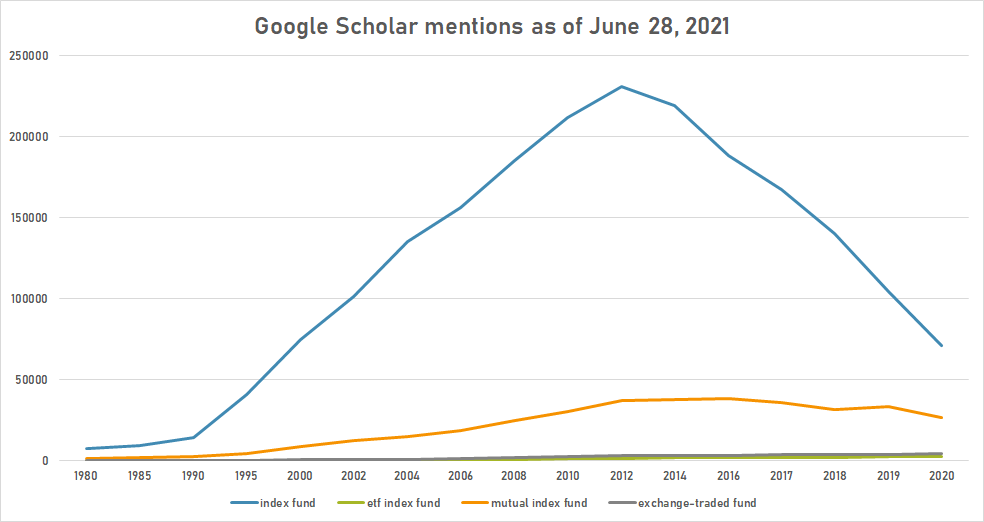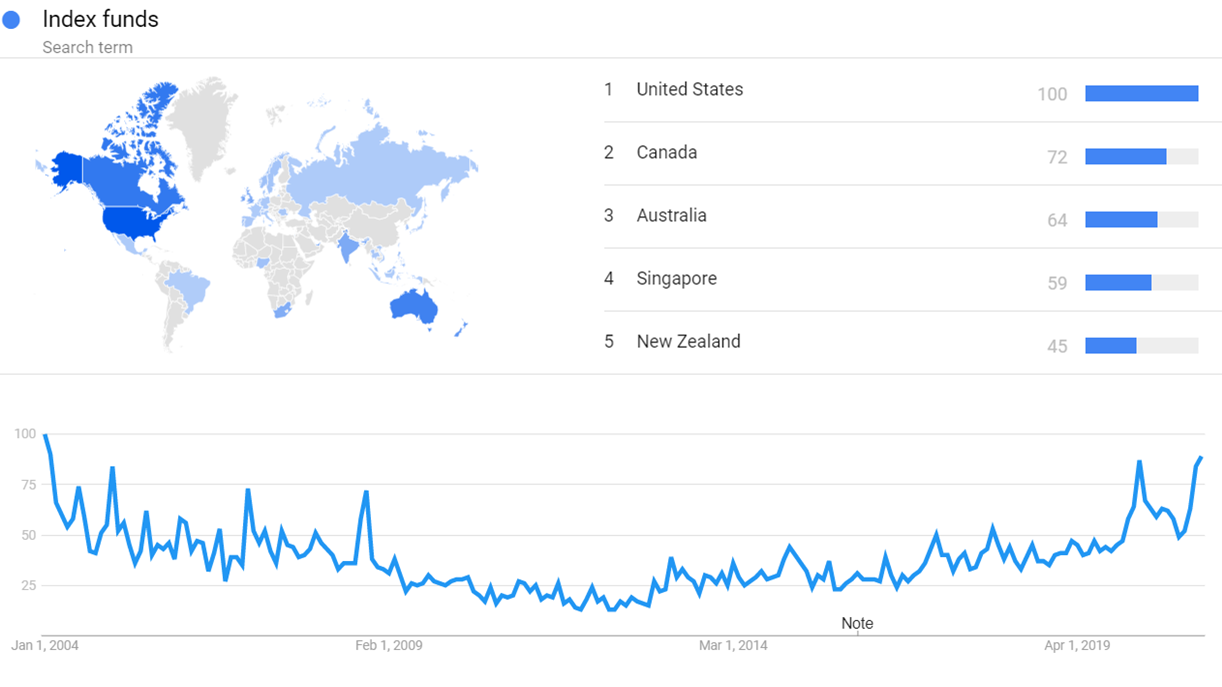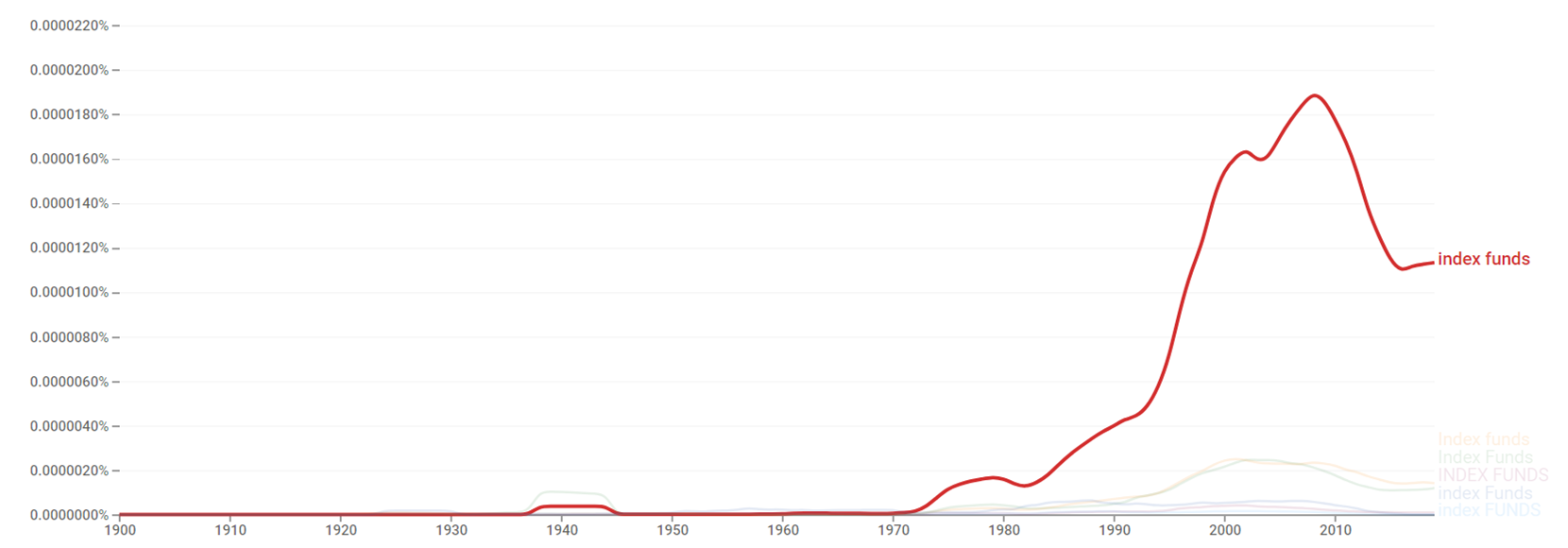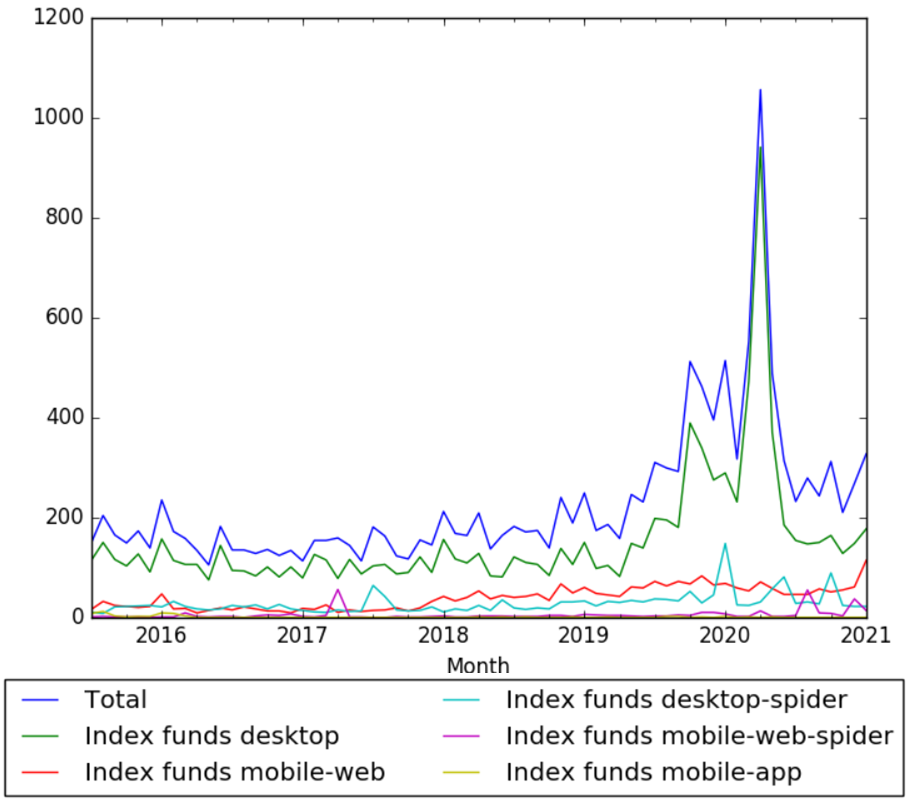Timeline of index funds
This is a timeline of index funds, attempting to describe the evolution of the concept as well as release of important funds.
Big picture
| Time period | Development summary |
|---|---|
| 1960s | A theoretical model for an index fund appears in the decade. |
| 1970s | Index funds are first developed. |
| 1980s | Competing index funds emerge. |
| 1990s | Index investing becomes popular. The acceptance of index funds accelerates. |
Full timeline
| Year | Event type | Details | |
|---|---|---|---|
| 1960 | Concept development | The first theoretical model for an index fund is suggested by Edward Renshaw and Paul Feldstein, both students at the University of Chicago. While their idea for an "Unmanaged Investment Company" garners little support, it would start off a sequence of events in the 1960s that would lead to the creation of the first index fund in the next decade.[1][2] | |
| 1967 | Organization | Qualidex Fund, Inc., a Florida Corporation, is chartered by Richard A. Beach.[3] | |
| 1971 | Concept development | Batterymarch Financial Management of Boston independently decides to pursue the idea of index investing.[4] | |
| 1971 | Fund release | Wells Fargo launches an early index fund, consisting of an equal weighting of all the stocks listed on the New York Stock Exchange, about 1,500. However, constant rebalancing and excessive transaction costs turn the running of the fund very difficult.[5] | |
| 1972 | Fund release | Early index fund is created by Qualidex Fund, Inc.[2] It is based on the Dow Jones Industrial Average of 30 stocks.[6] | |
| 1973 | Fund release | American financial executive Rex Sinquefield convinces his then employer, American National Bank of Chicago, to develop one of the first market-capitalization weighted S&P 500 index funds. Established in 1973, the fund is only available to institutions, and the New York Telephone Company becomes its first major investor.[7][5] | |
| 1973 | Fund release | Wells Fargo launches new fund tracking the S&P 500 in a market-cap weighted closed-end fund for institutional investors. The fund launch is assisted by John McQuown and David G. Booth.[5][7] | |
| 1973 | Fund release | John McQuown and David G. Booth of Wells Fargo, and Rex Sinquefield of the American National Bank in Chicago, establish the first two Standard and Poor's Composite Index Funds.[8] | |
| 1973 | Literature | American economist Burton Malkiel writes A Random Walk Down Wall Street, which presents academic findings for the lay public. At the time it is becoming well known in the popular financial press that most mutual funds are not beating the market indices.[6][2] The book includes one of the earliest calls for indexing.[4] | |
| 1974 | Organization | American investor John C. Bogle founds the Vanguard Group of Investment Companies.[9][10][11][2] | |
| 1974 | Fund release | The first multiclient index fund is probably launched by Batterymarch Financial Management.[12] | |
| 1975 | Organization | John Bogle founds The Vanguard Group to create a new way of investing.[5] | |
| 1975 | Fund release | The Vanguard Group creates the world’s first index mutual fund.[13] | |
| 1976 | Organization | The First Index Investment Trust is launched. It would soon attract much derision for its central premise: That just buying and holding the broad stock market would provide better results than trying to beat it by picking stocks.[14][15] | |
| 1981 | Organization | Rex Sinquefield and David G. Booth team up to launch Dimensional Fund Advisors, a mutual fund company committed to the construction of asset class funds that efficiently capture the specific market risk factors identified by Eugene Fama and Kenneth French.[7] | |
| 1984 | Fund release | Wells Fargo creates the second index mutual fund (Stagecoach Corporate Stock Fund).[16][17][18][19] | |
| 1985 | Fund release | The first bond index fund is in the early conceptual stages.[20] | |
| 1986 | Fund release | Colonial Index Trust is launched.[21][13] | |
| 1986 | Fund release | The first bond index fund for individual investors is formed.[18] | |
| 1987 | Fund release | The Vanguard Extended Market Index Fund is created.[13] | |
| 1987 – 1990 | Concept development | The conceptual framework of the Vanguard index fund "family" is established, and the implementation of the strategy begins.[18] | |
| 1988 | Fund release | Fidelity 500 Index Fund is launched.[22][13] | |
| 1990 | Growth | The First Index Investment Trust, renamed the Vanguard 500, reaches U$1 billion in assets 1990.[16] | |
| 1990 | Index release | Vanguard launches an extended market index, tracking the Wilshire 4500 Index, which is composed of all investable U.S. stocks not held in the S&P 500.[19] | |
| 1991 | Fund release | Galaxy Funds opens an index fund of govenment long bonds.[20] | |
| 1991 | Index release | Charles Schwab Co. opens its Short-Term Bond Market Index.[20] | |
| 1992 | Fund release | The Vanguard Total Stock Market Index Fund is designed to provide investors with exposure to the entire U.S. equity market, including small-, mid-, and large-cap growth and value stocks.[23] | |
| 1993 | Fund release | Vanguard creates the first specific-maturity bond index funds. The Long-Term Bond, Intermediate-Term Bond, and Short-Term Bond Portfolios of Vanguard Bond Index Fund are modeled after the comparable segments of the Lehman Brothers Aggregate Bond Index.[18][20] | |
| 1994 – 1996 | Concept development | The index fund concept becomes firmly established in the minds of serious investors, and gains considerable attention in the press.[18] | |
| 1995 | The founders of Victoria Capital Management (a venture capital firm specializing in growth stage companies) create an active asset allocation model using a variety of indexed funds. The structure of a range of portfolios with different weightings allows for the active management of these indices based on long‐term return characteristics and traditional economic and market analyses.[6] | ||
| 1995 | Literature | Vanguard publishes a booklet titled The Triumph of Indexing, which describes the whys and wherefore of the remarkable success of the concept of indexing.[4] | |
| 1996 | Notable review | Warren Buffet writes in the Annual Report of Berkshire Hathaway Corporation:
Most investors, both institutional and individual, will find that the best way to own common stocks is through an index fund that charges minimal fees. Those following this path are sure to beat the net results (after fees and expenses) delivered by the great majority of investment professionals.[13] | |
| 1996 | Fund release | Vanguard launches the Total International Portfolio as a "fund of funds", a composite of underlying European, Pacific, and Emerging Markets Portfolios.[18] | |
| 1997 (May 19) | Fund release | Schwab S&P 500 Index Fund (SWPPX) is incepted.[24] | |
| 1997 | Growth | The acceptance of index funds accelerates.[18] | |
| 1999 | Organization | Index Fund Advisors is founded in California as an investment advisory and wealth management company.[25][26] | |
| 2007 | Growth | To date, the Vanguard 500 Index Fund remains the largest mutual fund in the world.[5] | |
| 2008 | Notable forecast | Warren Buffett makes a bet that an S&P 500 index fund would beat a basket of actively managed hedge funds over 10 years. By the end of 2017, it would be clear Buffett won the bet.[27] | |
| 2012 (June) | Growth | As of date, there are about 1200 index ETFs in the United States, with about 50 actively managed ETFs. Index ETF assets are about US$1.2 trillion, compared with about $7 billion for actively managed ETFs.[28] | |
| 2017 | Fund release | Bitwise establishes the world’s first cryptocurrency-based index fund, called the Bitwise 10 Private Index fund. Its approach is based on the cryptocurrencies in their Bitwise 10 Large Cap Crypto Index — a collection of the ten largest coins, weighted by their 5-year diluted market capitalization. The index includes Bitcoin, Ethereum, Ripple, EOS, Litecoin, Bitcoin Cash, Steller, Dash, Monero, and Zcash.[2] |
Numerical and visual data
Google Scholar
The following table summarizes per-year mentions on Google Scholar as of June 28, 2021.
| Year | index fund | etf index fund | mutual index fund | exchange-traded fund |
|---|---|---|---|---|
| 1980 | 7,280 | 16 | 1,330 | 16 |
| 1985 | 9,140 | 12 | 1,490 | 31 |
| 1990 | 13,800 | 10 | 2,540 | 72 |
| 1995 | 40,700 | 29 | 4,180 | 148 |
| 2000 | 74,800 | 62 | 8,250 | 311 |
| 2002 | 101,000 | 134 | 12,000 | 562 |
| 2004 | 135,000 | 235 | 14,900 | 777 |
| 2006 | 156,000 | 322 | 18,400 | 1,080 |
| 2008 | 185,000 | 644 | 24,500 | 1,660 |
| 2010 | 212,000 | 981 | 30,100 | 2,100 |
| 2012 | 231,000 | 1,300 | 36,800 | 2,860 |
| 2014 | 219,000 | 1,550 | 37,500 | 3,070 |
| 2016 | 188,000 | 1,670 | 38,100 | 3,080 |
| 2017 | 167,000 | 1,880 | 35,900 | 3,330 |
| 2018 | 140,000 | 1,970 | 31,500 | 3,580 |
| 2019 | 104,000 | 2,190 | 33,400 | 3,760 |
| 2020 | 71,000 | 2,350 | 26,600 | 4,160 |

Google Trends
The image below shows Google Trends data for Index funds (Search term), from January 2004 to February 2021, when the screenshot was taken. Interest is also ranked by country and displayed on world map.[29]

Google Ngram Viewer
The chart below shows Google Ngram Viewer data for Index funds, from 1900 to 2019.[30]

Wikipedia Views
The chart below shows pageviews of the English Wikipedia article Index funds, on desktop, mobile-web, desktop-spider, mobile-web-spider and mobile app, from July 2015 to January 2021.[31]

Meta information on the timeline
How the timeline was built
The initial version of the timeline was written by User:Sebastian.
Funding information for this timeline is available.
Feedback and comments
Feedback for the timeline can be provided at the following places:
- FIXME
What the timeline is still missing
- [1]
- A column for stock exchanges?
Timeline update strategy
See also
External links
References
- ↑ Fox, Justin (2011). "Chapter 7: Jack Bogle takes on the performance cult (and wins)". The Myth of the Rational Market. USA: HarperCollins. pp. 111–112. ISBN 978-0-06-059903-4.
- ↑ 2.0 2.1 2.2 2.3 2.4 "The History of Index Funds & The Future of Diversifying Your Crypto Investments". medium.com. Retrieved 16 April 2019.
- ↑ "INDEX FUND". alphazadvisors.com. Retrieved 22 April 2019.
- ↑ 4.0 4.1 4.2 "The First Index Mutual Fund: A History of Vanguard Index Trust and the Vanguard Index Strategy". vanguard.com. Retrieved 22 April 2019.
- ↑ 5.0 5.1 5.2 5.3 5.4 Carrel, Lawrence. ETFs for the Long Run: What They Are, How They Work, and Simple Strategies for Successful Long-Term Investing.
- ↑ 6.0 6.1 6.2 "The Value of Active Index Management" (PDF). vcm.us.com. Retrieved 22 April 2019.
- ↑ 7.0 7.1 7.2 "1973 - The Birth of Index Funds". ifa.com. Retrieved 10 May 2019.
- ↑ "INDEX INVESTING". self.gutenberg.org. Retrieved 10 May 2019.
- ↑ "The Vanguard Group Of Investment Companies". encyclopedia.com. Retrieved 22 April 2019.
- ↑ "John C. Bogle, Founder of Financial Giant Vanguard, Is Dead at 89". nytimes.com. Retrieved 22 April 2019.
- ↑ "A look back at the life of Vanguard's founder". investornews.vanguard. Retrieved 22 April 2019.
- ↑ Johnson, Bruce. The Hedge Fund Fraud Casebook.
- ↑ 13.0 13.1 13.2 13.3 13.4 "Vanguard's index funds: A history of evolution for investors". foxbusiness.com. Retrieved 16 April 2019.
- ↑ "A Brief History of Indexing". morningstar.com. Retrieved 16 April 2019.
- ↑ "This Day In Market History: Vanguard Launches First Index Fund For US Retail Investors". benzinga.com. Retrieved 16 April 2019.
- ↑ 16.0 16.1 "Today in Market History, The First Index Fund". theirrelevantinvestor.com. Retrieved 16 April 2019.
- ↑ "Father of passives has doubts about ETFs". ft.com. Retrieved 16 April 2019.
- ↑ 18.0 18.1 18.2 18.3 18.4 18.5 18.6 Neubert, Albert S. Indexing for Maximum Investment Results.
- ↑ 19.0 19.1 Ferri, Richard A. The Power of Passive Investing: More Wealth with Less Work.
- ↑ 20.0 20.1 20.2 20.3 Martellini, Lionel; Priaulet, Philippe; Priaulet, Stéphane. Fixed-Income Securities: Valuation, Risk Management and Portfolio Strategies.
- ↑ Neuberg, Albert S. Indexing for Maximum Investment Results.
- ↑ "Fidelity 500 Index Fund". bloomberg.com. Retrieved 22 April 2019.
- ↑ "Vanguard Total Stock Market Index Fund Investor Shares (VTSMX)". investor.vanguard.com. Retrieved 18 April 2019.
- ↑ "Schwab S&P 500 Index Fund (SWPPX)". finance.yahoo.com. Retrieved 4 August 2020.
- ↑ "Careers at Index Fund Advisors". ifa.com. Retrieved 22 April 2019.
- ↑ "Mark Hebner". ifa.com. Retrieved 22 April 2019.
- ↑ "Why Index Funds Should Be Every Investor's Best Friend". moneywise.com. Retrieved 15 April 2019.
- ↑ "ETF Statistics For June 2012: Actively Managed Assets Less Than 1%". ETF Daily News. Archived from the original on December 12, 2017. Retrieved December 12, 2017.
{{cite news}}: Unknown parameter|deadurl=ignored (|url-status=suggested) (help) - ↑ "Index funds". Google Trends. Retrieved 28 February 2021.
- ↑ "Index funds". books.google.com. Retrieved 28 February 2021.
- ↑ "Index funds". wikipediaviews.org. Retrieved 28 February 2021.